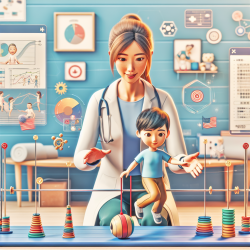As practitioners dedicated to fostering optimal outcomes for children, it is imperative that we leverage the latest research to inform our practices. A recent study titled Postural Control in Children With Developmental Coordination Disorder by Reint H. Geuze provides valuable insights into the balance challenges faced by children with Developmental Coordination Disorder (DCD). By understanding these findings, we can better tailor our interventions to support these children more effectively.
Understanding the Research
The study investigates the postural control mechanisms in children with DCD, particularly focusing on their ability to maintain static balance. It was observed that under normal conditions, static balance control is not significantly problematic for children with DCD. However, in more challenging or novel situations, these children exhibited increased postural sway, indicating difficulties in maintaining balance.
One key finding is the weaker coupling between electromyography (EMG) signals and corrective force in children with DCD compared to their peers. This suggests non-optimal balance control, likely due to cerebellar involvement. The tibialis anterior and peroneus muscles were notably involved in lateral balance control across all groups studied.
Implications for Practice
Based on these findings, practitioners can implement several strategies to enhance postural control in children with DCD:
- Targeted Muscle Strengthening: Focus on exercises that strengthen the tibialis anterior and peroneus muscles, which are crucial for lateral balance control. Incorporating balance-focused activities such as one-leg stands or dynamic balance exercises can be beneficial.
- Incremental Challenge Introduction: Gradually introduce more challenging balance tasks to help children adapt to novel situations. Start with simple tasks and progressively increase the difficulty as the child gains confidence and control.
- Use of Sensory Feedback: Incorporate sensory feedback mechanisms such as visual or auditory cues to help children with DCD better understand and control their postural adjustments.
- Consistent Monitoring and Adjustment: Regularly assess the child's progress and adjust the intervention strategies accordingly. Use data-driven approaches to ensure that the interventions are effective and tailored to the child's specific needs.
Encouraging Further Research
While the study provides a strong foundation, there is always room for further research to refine our understanding and approaches. Practitioners are encouraged to stay updated with the latest research and consider participating in or conducting studies that explore new interventions and their efficacy. Collaboration with researchers can also provide valuable insights and contribute to the broader body of knowledge in this field.
Conclusion
By integrating the findings from the study Postural Control in Children With Developmental Coordination Disorder into our practice, we can significantly improve the outcomes for children with DCD. Implementing targeted interventions and continuously refining our approaches based on evidence will ensure that we provide the best possible support for these children.
To read the original research paper, please follow this link: Postural Control in Children With Developmental Coordination Disorder.










